


 |
August 19-21, 1981: A Trip to New York City |
 |
April 28-29, 1981: Two Days in Frankfurt, Germany |
 |
Return to the Index for 1981 |
Well, after my stop in Frankfurt I was on my way to a part of the world I never thought I might visit- the Middle East. I was a little apprehensive about this particular trip, knowing how volatile the area is, but I thought that I might never again have the opportunity to go, so I took it. My flight to Saudi Arabia was uneventful. It took about seven hours; the Middle East is actually quite far from central Europe. There were lots of Westerners on the airplane, but also many individuals that fit my impression of what Arabs might look like. There were a few persons in Arab dress, but not many. I was also struck by how few women there were- it seemed as if the flight was populated entirely by businessmen. The service was good, about what one expects from Lufthansa.
Saudi Arabia and the City of Dhahran
|
Large oil reserves were first identified in the Dhahran area in 1931, and in 1935, Standard Oil drilled the first commercially viable oil well. Standard Oil later established a subsidiary in Saudi Arabia called the Arabian American Oil Company (ARAMCO)- the company I will be doing work for on this trip. I did learn while I was here, that the Saudi Government in recent years acquired a majority stake in the company, and that it is currently in the process of taking full control of it and making it fully government-owned.
Dhahran has been the home of Aramco's headquarters for 50 years; the headquarters is located on Saudia Arabia's first and largest gated compound and there are some 7,500 residents. The reason for the compound seems to be that business could not be conducted in the manner necessary were the area publicly accessible; religious restrictions would be too onerous. While the country's laws do apply on the compound, wide latitude in their observation seems to be the rule.
The International Hotel in Dhahran
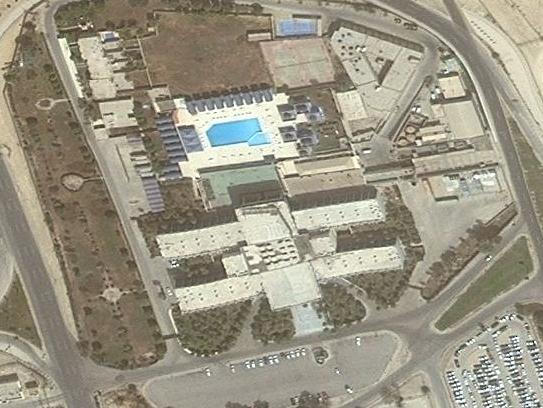 |
When I showed the customs officer my visa, though, which allowed me to travel only within the Dhahran area, he remarked that there wasn't much that would be considered off-limits for me in this particular area. The whole search took about thirty minutes, and I only had one suitcase. It appeared as if persons known to the customs agents moved through quickly, though.
The ARAMCO people had sent a car for me, and the driver took me a short distance to the International Hotel, about the only hotel in the area for Westerners. The ARAMCO personnel live on the ARAMCO compound, which is a lot like a military base in that respect. The hotel itself was quite nice, and fairly luxurious, with luxurious prices to match, but then I was on an expense account so it didn't matter much.
The hotel itself was very, very nice, even if the area surrounding it looked like a huge construction site. The hotel was only a few minutes from the airport and about twenty minutes from the ARAMCO compound (and ARAMCO had a shuttle I could take each morning to get there).
|
As soon as I came out of the airport to meet my ride to the hotel, and for the remainder of my stay, I was glad that I had stocked up on casual, hot-weather clothing. The heat was pretty intense, and for almost all of my stay, the average high temperature during the day was in the low 90s; by the day I left it was climbing towards an average of 100. But I will admit that the heat reminded me of Phoenix; the humidity was almost non-existent most days, even though the Persian Gulf was not too far away.
Since I had a day to myself before my classes started, I thought I would just look around the hotel, and maybe sit by the pool for a while. I also thought I might walk out the front of the hotel to the small town that was just to the southwest.
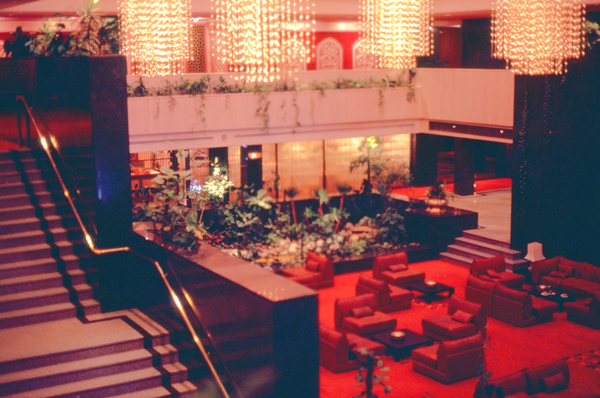 The Main Lobby of the Hotel |
The saying is a way of describing a generous man. Deriving its origin from survival in the harsh conditions in the desert, hospitality for the Bedouins is not merely a social grace. It can mean the difference between life and death. Charity is the third pillar of Islam, thus the generosity inherent in Saudi hospitality has both a religious and a cultural inspiration.
At the Dhahran International Hotel, he said, they have based their service on that saying, indicating that they strive to do anything and everything to make a guest feel comfortable. (Indeed, the phone in the room had the most extensive list of services I had seein in a long time. While his talk sounded as if he'd given it numerous times before, it certainly rang true, and there was nothing that I found I needed during my stay that the hotel didn't provide.
This was one place in the world where I didn't sample the local cuisine much. One reason is that in this area that caters to the oil industry and Westerners, there were not very many convenient Saudi restaurants; almost all of the restaurants there were served American or other foreign cuisine. So I basically just ate dinner in the hotel most of the time. There were three restaurants, although I never patronized the most upscale of the eateries, not wanting to spend $40 for a meal). I found the food quite good, and after a few days of American-style fare, I branched out into Middle Eastern food and found it delicious.
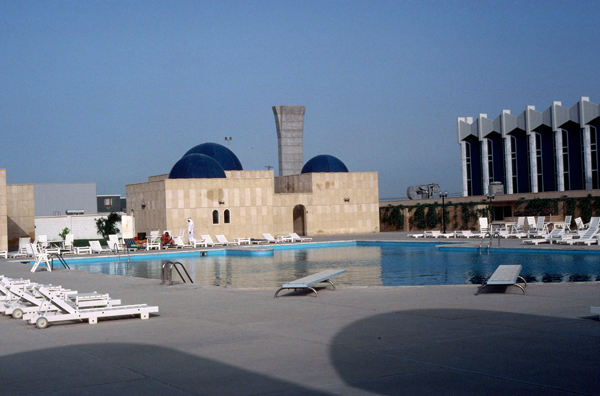 |
You can see that the pool itself is immense- certainly the biggest hotel pool I have seen. On the far side is an exercise room, and, just to the left, out of the picture, the men's dressing rooms and sauna. The weather was clear (in fact, there was no rain the entire time I was there, and only two days out of the three weeks that were even overcast) and the temperature was about 90-95 degrees. It reached 100 quite a few times while I was there, but since everything is air-conditioned, it didn't matter much. Also, the humidity is almost nil, which makes high temperatures easier to take.
I noticed when I saw the pool service menu that there were no alcoholic drinks listed; I think the hotel actually served them, but they were certainly not obvious about it. I found out later that most business people were spending this "weekend" day somewhere on the ARAMCO compound where the rules don't apply nearly so restrictively; the ARAMCO country club on the ARAMCO compound, serves mixed drinks, but even there it is low-key, and patrons are expected not to over-indulge. Later in my stay I was invited to a party in one of the Saudi's homes; once there, I couldn't distinguish the food, drink, and attire from anything you might see at a suburban American party. So I came to understand that the religious rules applied mostly to public actions; inside private homes the rules are frequently ignored.
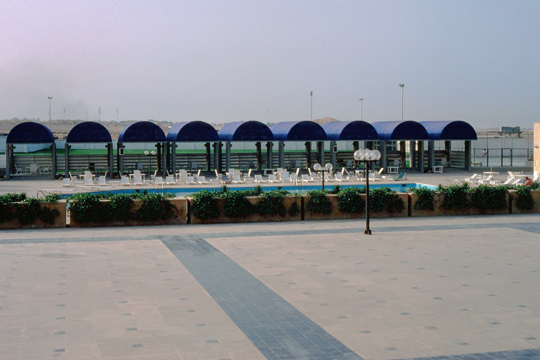 The Pool and Recreation Area at the Dhahran International Hotel This picture was taken from a point just outside the rear doors from the hotel that led out to the pool area. |
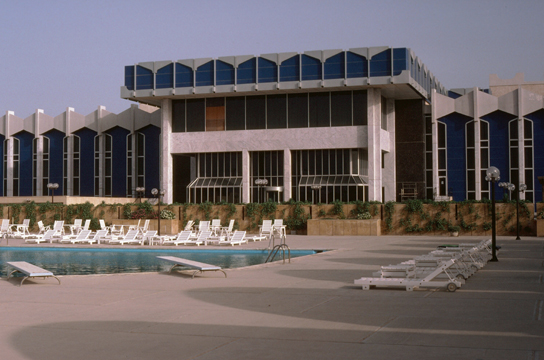 The Back of the International Hotel Leading to the Pool Area The picture at left was taken from just outside the doors you can see here. |
I did not yet know my way around the area near the hotel, so I felt uncomfortable straying far from it. When I had talked with my class organizers weeks earlier, they had advised that I just stick around the hotel until the first day of class; at that time they could give me some advice on places I might go and things I might see. Most of all, they could counsel me on how to interact with Saudi citizens.
My Pictures of Dhahran
|
It is not too hard to describe what the area around Dhahran looked like. If you imagine a large construction site from which all the trees have been cleared, and just the dirt and dust are left, if you take all the clouds out of the sky and raise the temperature into the 90's until all the humidity is basically gone, and if you put lots of actual construction of everything from roads to factories to oil installations around (with all the construction vehicles and workers), then you will have some idea of this part of Saudi Arabia.
Of course, Saudi Arabia is basically a desert, with the only natural greenery surrounding water sources. There has been a good deal of irrigation in this area, although no crops are grown, some of the major buildings, and certainly the ARAMCO installation, have lawns and trees. But all that had to be brought in; there is little indigenous vegetation.
Consequently, the typical Saudi street scenes consist of buildings mostly made of concrete, with streets that are either paved or hard-packed dirt. Saudis have all the modern conveniences, which you would expect given their oil income. This is the first place I have been outside the United States where American-made automobiles outnumbered those made in other countries. It seems that in Saudi Arabia there is still a cachet attached to owning a big American car. Part of that is that for Saudi citizens, gasoline is free.
As examples of the local "scenery", here are two pictures that I took one morning on the way from the hotel to the ARAMCO compound. On a few days, there were minor sandstorms (actually, just a lot of sand and pollution in the air):
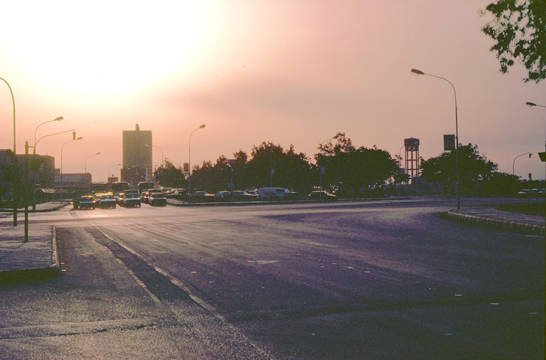 A Typical Road Scene |
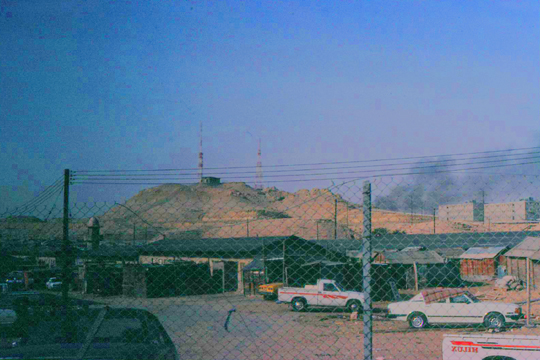 Alongside the ARAMCO Compound |
Each afternoon, after class, I took the opportunity to walk around or take one of the Saudi buses into the town of Dhahran. It seems that all the Saudis that don't work in the oil business are shopkeepers, and you can find anything you want, sometimes at what we would consider very good prices, in the Saudi stores.
|
One thing that struck me was the availability of cassette tapes and record albums. The prices were less than 25% of what they would be in the States, and I wondered about this. Someone at ARAMCO told me that Saudi Arabia does not prosecute citizens who violate international copyright laws- particularly for cassette tapes (I also saw some VHS videotapes as well). So the product that you see in the little shops are actually tapes made by copying actual manufactured originals. The "pirates" even copied the artwork and liner notes, so that the copies were virtually indistinguishable from legal copies (save for the occasional bit of marking in Arabic).
With no royalties to pay, and no development costs to amortize, the cost of a top-ten cassette is little more than the cost of the blank tape cassette itself. I understand there is some agitation to change this old practice, but I don't know for sure.
Going in and out of these little shops reminded me very much of the shops I visited in Seoul more than ten years ago. None of the shops were very big (the concept of a department store being apparently a foreign one), and each specialized in one kind of item or another. I saw a few clothing shops, and a couple of little groceries, but most of the stores were selling electronics, music and movies.
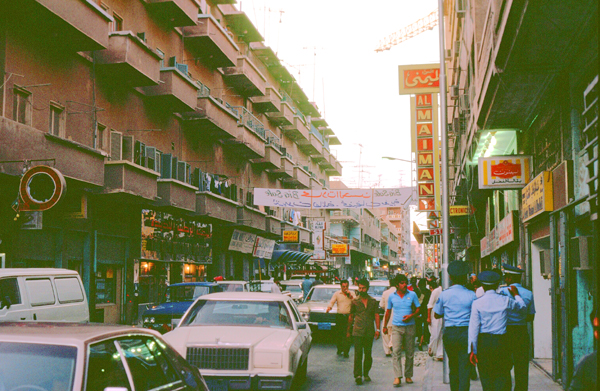 |
Muslims take these calls very seriously, and given that, one might think that everyone would simply remember when the prayer times are. The problem with that is that the prayer times vary from day to day and even from place to place. For example, here is the time rule for the sunset prayer: "The Maghrib prayer begins when the sun sets, and lasts till the red light has left the sky in the west". Got that? First off, you can easily see that the time for this prayer will vary from day to day at any given location, because the time for sunset changes with the seasons. You can also see that the time will be different depending on exactly where you are on the planet. Certainly, places on different longitudes will have different times for sunset, and so different times for the sunset prayer. Even two cities on the same longitude will have different times, as one will be north of the other. Finally, who determines when the "red light has left the sky in the west"? (What if it is cloudy, and there is no red lightt?) These are all reasons why muezzins are used; they are supposed to know all these things.
The time it takes to perform the prayers differs as well, I understand, although it seemed to me that it was always about five minutes or so. Whenever the time actually is, the Muslim faithful get out their prayer rugs, spread them out, bow towards Mecca (somewhat west of Dhahran) and perform their prayers.
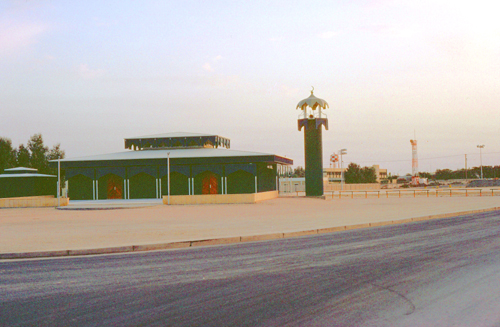 |
But there were a number of times when I was inside a shop or store when the prayer call came. At these times, customers were ushered outside, the store was closed up, and, presumably, the store personnel either hurried to the nearest mosque for prayers, or simply got out their prayer rugs and prayed inside the store. When prayers are over, the store would reopen and business would continue as usual. Non-Muslims are not expected to pray, but are expected to act respectfully during this time. If they wish, they may wait outside the store until it is reopened, which is the common practice since there is nowhere else to go. Shopkeepers who are not Muslim are also expected to suspend business for the duration, even though they are not required to close their stores.
I recall riding on a Saudi bus at prayer call one day. The bus driver brought the bus to a stop and all the Saudis got out and performed their prayer ritual outside on the ground while the few non-Muslims on the bus sat in silence or read or just watched.
Muslims are very sensitive about their religion, and will not tolerate any sort of denigration. That is one reason why the customs officials are so vigilant about what is brought into the country and whether it could be detrimental to the standard ways of doing things. There is a certain amount of hypocrisy, though, as even devout Saudi Muslims will drink alcohol and engage in other non-approved practices. This is usually done in private, but the wealthier you are the more likely you are to be able to skirt the laws on occasion. Stories abound of scandal within the royal family itself, but it is not considered polite or even healthy to discuss these matters openly.
I would like to say that the scenery back and forth to the ARAMCO compound was at least interesting, but it really wasn't. One day, I took my camera to the compound, and on the way took a couple of pictures through the windshield:
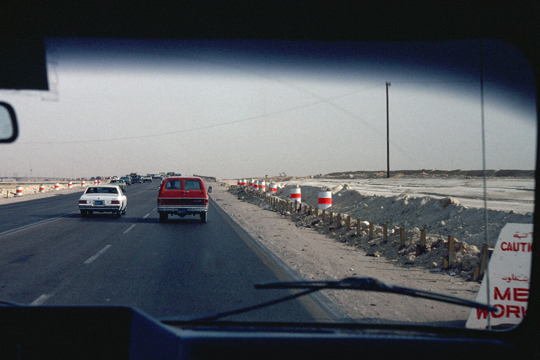 Here is one view from the bus from the hotel to the ARAMCO compound. As you can see, the land is basically flat and featureless. |
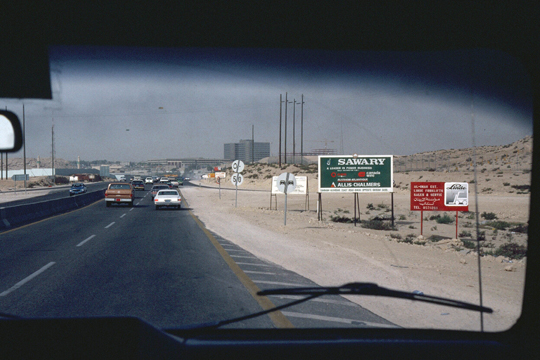 Here's another view from the bus; that is the administration building for this ARAMCO installation in the distance. |
The shuttle bus was certainly convenient; it ran pretty much continuously in the morning and afternoon, so I didn't have to drive. Just as well, since Saudi drivers are not very good; they are like Korean drivers with larger cars. It seems as if traffic accidents are commonplace. Most foreigners do not drive; the laws governing traffic accidents are very strict. Compensation for the victim is expected to be immediate, and depends on the rank of the victim. For example, if you run into someone's bumper and dent it, you are supposed to be able to pay the claim on the spot, or at least reach some agreement with the injured party. There is no such thing as insurance. The situation is so chaotic that foreigners simply do not drive while in the country, except on the ARAMCO compound itself.
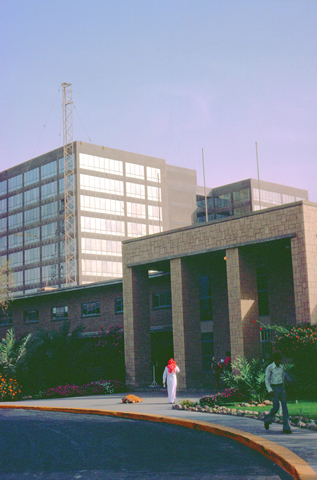 |
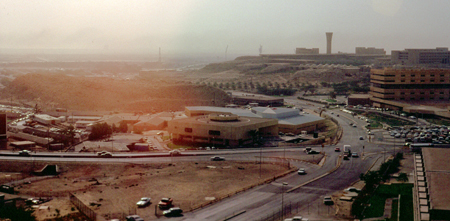 |
The computer installation is both larger and more up-to-date than the functions going on here would seem to require; indeed, I saw one room with an IBM mainframe that appeared to be unused- the power was on but no one was doing anything with it. I thought that was odd, as there seems to be no attention given to the cost-effectiveness of purchasing of these items. In fact, in our course, we have a section on making the determination as to whether the purchase of hardware can justified based on the benefits expected from its purchase.
It was at this point that one of the managers in the class explained to me that these issues of cost have little relevance for ARAMCO. By way of explanation, he indicated that the ARAMCO budget for computers, for example, is for all practical purposes unlimited. If a new computer is introduced, by IBM say, ARAMCO will immediately buy a few of them and just warehouse them until they are put to use. If they are never used, they are just eventually sold off.
This seemed very wasteful to me, but then this same manager explained that ARAMCO pumps about 5 million barrels of oil a day, and charges about $12 for each of them. That is a gross revenue of about $60 million per day. The oil costs ARAMCO, counting all the expenses of exploration, drilling, pumping and getting it onto a ship, about 59 cents a barrel. That is a net profit, per day, of some $57 million. Spending 1/100 of that for a new computer once a month is chicken feed.
Here are my last two pictures from Saudi Arabia. Both were taken from the Administration Building. The compound seems to be rapidly expanding, and construction cranes are everywhere:
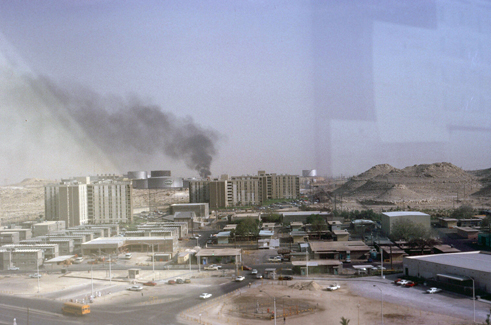 |
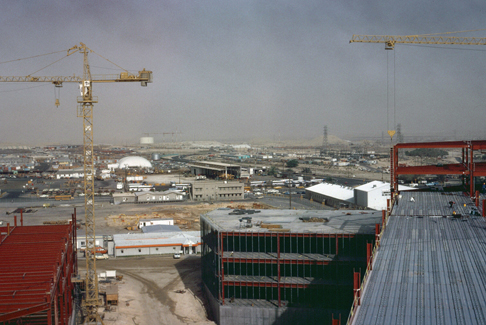 |
While I was in the country, I was working most of the time, and did not get a chance to tour around. Even if I had the time, it is difficult to get permission to just travel around the country. It is necessary for Westerners to get specific permission (a visa) to go to, say, Riyadh or Jedda. For someone only there for a short time, ARAMCO didn't want to go to the trouble necessary to arrange these kind of documents for me, nor is this usually done for anyone who is not there permanently. In any event, there are not many places to go and see, the two sites I mentioned being about the only ones. So I don't have the volume of pictures that I might have had were this an area like London or Paris.
Anyway, the trip to Saudi Arabia was enjoyable, and the people I worked with were certainly friendly enough. I attended two or three private parties in private homes, and each of these dinners was quite nice. And for the other reasons that I talked about in my diary note, this trip to Saudi Arabia will always be extremely memorable for me, if not the most important trip I have taken, for reasons having nothing whatever to do with business, finances, or my career, but with my discovery, at long last, of who and what I am.
My two weeks of classes now over, I am heading back to Chicago with a sense of anticipation. There is a whole world that I knew existed but never knew I was a part of, and I am anxious to explore it. Perhaps I will be able to fill a missing dimension in my life- my lack of someone to share things with- at long last. Better late than never, I guess. My thanks to the accountant from New Jersey, whomever he may be.
You can use the links below to continue to another photo album page.
 |
August 19-21, 1981: A Trip to New York City |
 |
April 28-29, 1981: Two Days in Frankfurt, Germany |
 |
Return to the Index for 1981 |